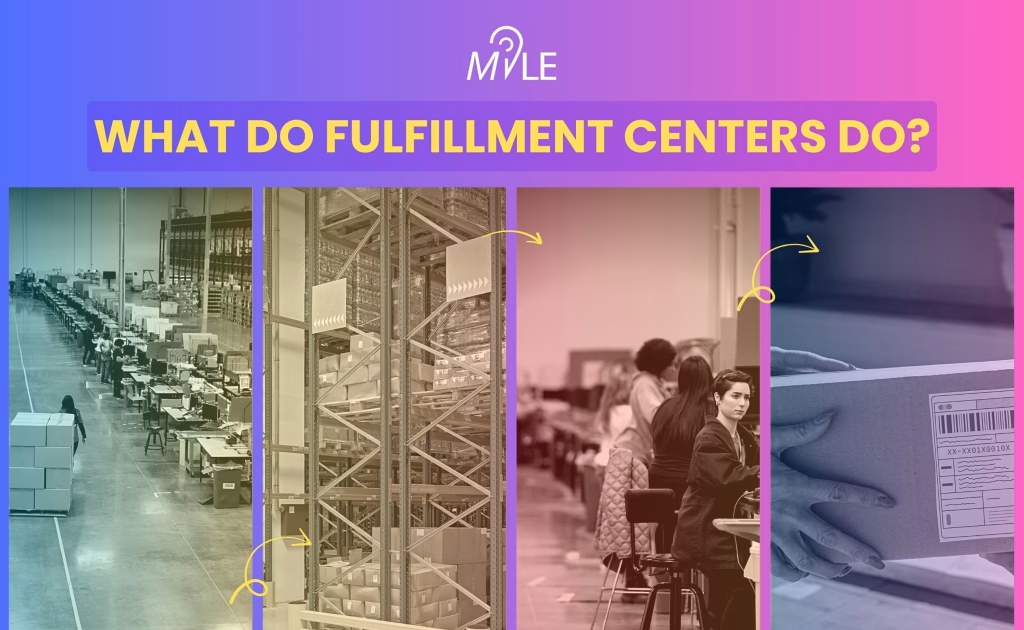What Do Fulfillment Centers Do? A Complete Guide for eCommerce Sellers
Running an online business involves more than listing products and collecting payments. Every order needs to be picked, packed, and shipped, and that process needs to happen quickly and reliably.
Many growing businesses turn to fulfillment centers to handle that part of the job. These facilities play a major role in how products move from seller to customer.
In this guide, we’ll explain what a fulfillment center does, how it works, and how it compares to warehouses and distribution centers. You’ll also learn how fulfillment center software helps businesses improve delivery performance and increase customer satisfaction.
What Is a Fulfillment Center?
A fulfillment center is a third-party facility that handles the storage, packing, and shipping of products on behalf of eCommerce businesses. When sellers outsource this part of their logistics, it means they’re working with a 3PL fulfillment center.
For the uninitiated, the term 3PL stands for third-party logistics, and it refers to services that handle transportation, warehousing, and order fulfillment for other companies.
When someone places an order online, the fulfillment center receives that order, picks the item from storage, packs it, and arranges for delivery through a shipping carrier. Some centers also manage returns, inventory tracking, and custom packaging.
A fulfillment center is generally used by businesses that sell physical products and need a reliable way to deliver them to customers. These centers can process a high number of orders quickly, including periods with heavy traffic and increased customer activity.
How Do Fulfillment Centers Work?
The regular workflow commences when a business ships its inventory to the fulfillment center. The facility checks and stores the inventory in an organized system that allows for quick access. Products are stored in bins or shelves, labeled with barcodes, and tracked using a warehouse stock management system.
Once the inventory is in place, the fulfillment center is ready to process orders. Here is how the typical workflow goes:
1. استلام المخزون
Businesses send their products to the fulfillment center. The center logs the items, checks quantities, and adds them to the inventory system. This step is essential for accurate stock management.
2. Storage
Products are stored in a way that allows workers to locate them quickly when an order arrives. Items with high sales volume are usually placed near packing stations. Proper labeling and stock rotation help maintain order accuracy.
3. معالجة الطلبات
When a customer places an order, the system retrieves the details and sends them to the fulfillment center. The software generates a picking list, which guides staff through the building to collect the ordered items.
4. Picking and Packing
Once the items are picked, they are packed according to the seller’s specifications. Some businesses want simple packaging, while others prefer branded boxes and inserts.
5. Shipping
After packing, the fulfillment center creates a shipping label and schedules a pickup with a carrier. Tracking information is sent back to the seller or directly to the customer.
6. Handling Returns
Many fulfillment centers also receive and process returned items. They inspect the returned products and decide whether to restock, discard, or hold them for review.
Fulfillment Center vs Warehouse
It’s common to confuse fulfillment centers with warehouses, but they have different functions. A warehouse is primarily used for storing goods over long periods. It holds large quantities of inventory and is often part of a manufacturer or wholesaler’s supply chain.
A fulfillment center, by contrast, is focused on getting individual orders shipped to customers. Inventory in a fulfillment center moves more quickly. The center is organized to support fast picking, packing, and shipping, rather than long-term storage.
The tools used also differ. A warehouse may depend on a basic inventory system. A fulfillment center, on the other hand, uses fulfillment software. This platform integrates with online stores, shipping carriers, and inventory databases to ensure accurate and timely delivery.
Fulfillment Center vs Distribution Center
Fulfillment centers and distribution centers are different because of the type of orders they handle and their workflows.
A distribution center is a hub that moves goods in bulk between manufacturers, warehouses, or retail locations. It is most commonly used in B2B supply chains and handles pallets or large shipments.
In contrast, a fulfillment center operates on direct-to-consumer shipping. It handles smaller, individualized packages. The workflow is geared toward picking single items and delivering them to residential addresses. Distribution centers tend to move goods in batches, while fulfillment centers manage high volumes of small, personalized orders.
Who Uses Fulfillment Centers?
Fulfillment centers are widely used by eCommerce brands, online retailers, subscription box companies, and direct-to-consumer startups. These businesses lack the space, staff, or time to manage packing and shipping themselves.
For example, a small clothing brand that ships 300 orders per month might spend hours each day packing and labeling. As sales grow, that workload becomes unsustainable. By partnering with a 3PL fulfillment center, the brand can spend more time on design, marketing, and customer service while the center handles fulfillment.
Fulfillment services also help international sellers who want to ship locally in a different region. When sellers store inventory in a regional fulfillment center, they can dispatch and deliver their orders faster.
Benefits of Using a Fulfillment Center
The advantages of using a fulfillment center go beyond mere convenience. These facilities can improve order accuracy, reduce delivery time, and help businesses grow more efficiently.
Faster Shipping
Most fulfillment centers are located near major cities or shipping routes. When businesses store inventory closer to customers, orders arrive faster and shipping costs go down.
Lower Operational Costs
Instead of renting storage space and hiring staff, sellers can pay a fixed fee per order. This structure makes costs easier to predict and scale. Carriers also provide lower rates to fulfillment centers due to large shipment volumes. This helps eCommerce businesses save money on logistics.
Improved Order Accuracy
Fulfillment centers use barcode scanners and inventory systems to reduce errors. Orders are picked and packed based on system-generated lists. This leads to fewer packing mistakes and better order accuracy.
Better Inventory Management
Fulfillment center software and warehouse stock management systems allow sellers to monitor stock levels in real time. These tools can send alerts when inventory is low and track which items are selling quickly.
Easier Returns Handling
Many fulfillment centers offer reverse logistics services. They can receive returned items, check them for damage, and update stock levels automatically. This keeps your records accurate and also saves time.
When to Consider a Fulfillment Center
A business might consider working with a fulfillment center under several conditions:
- Order volume is growing beyond what the team can handle manually
- Storage space at home or in a small warehouse is running out
- Customers are requesting faster delivery or tracking information
- Shipping costs are unpredictable or too high
- Inventory tracking has become complicated
If any of these apply, a fulfillment partner could make your day-to-day operations more manageable.
Why Implement Fulfillment Center Software
Fulfillment center software connects your online store to the fulfillment provider, automates order transfers, and keeps stock levels updated. It also integrates with tools like a driver app, proof of delivery, and payment gateway to create a clear, end-to-end workflow from the time an order is placed to the moment it reaches the customer.
For example, Mile’s software provides tools for managing multi-stop route planning, dispatch schedules, and fixed delivery routes. Businesses can track packages across carriers, view reports on delivery performance, and identify problem areas before they affect customer satisfaction.
الأفكار النهائية
Fulfillment centers are instrumental in eCommerce because they handle all key aspects of the business, from storing and managing inventory to picking and packing to dispatch and delivery of products. For many businesses, they provide a reliable way to deliver orders on time and at scale.
If your eCommerce store is growing, your team is overwhelmed with shipping, or your customers want faster deliveries, it may be time to use technology to streamline and automate your fulfillment and logistics workflows.
Schedule a demo with Mile to standardize order management, track inventory, and handle shipping across all locations.


